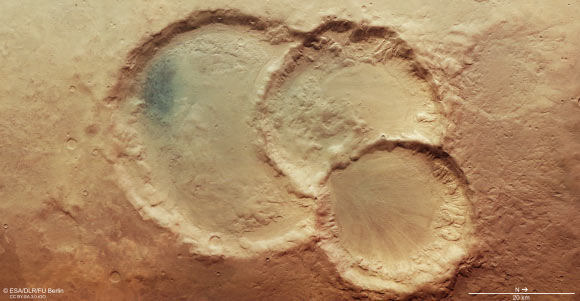ESA’s Mars Express orbiter has spotted three overlapping craters in Noachis Terra, an extensive landmass in the southern hemisphere of Mars.
Source: Sci News
The highland regions of the southern hemisphere of Mars are covered with impact craters, which are much more numerous than in the Martian northern hemisphere, which proves that these regions are among the oldest on the planet.
One of these regions is called Noachis Terra and gave its name to the Noachian period, an epoch that lasted from approximately 4.1 to 3.7 billion years ago and was marked by a strong bombardment by meteorites and asteroids.
In this early phase of the planet, large regions were topographically shaped, hence the name Noah, after the ark builder in the Old Testament.
Some of the features created by the ancient bombardment remain intact on Mars today and, as they formed during the very earliest days of the Solar System, are of particular interest to scientists seeking to know more about our planetary neighbor and its past.
The newly-released Mars Express images show a triple crater found just east of a better-known feature named Le Verrier Crater, which spans nearly 140 km (87 miles) across.
By contrast, the three depressions seen here are somewhat smaller; the largest measures 45 km (28 miles) across, and the smallest 28 km (17.4 miles).
How would such a crater triplet form? One possible explanation — and that thought to be most likely — is that the impactor broke into three before hitting the ground, forming a crater trio upon impact.
Not all ‘multiple impactors’ leave such clear and neat features in their wake, with many instead showing elongated troughs, non-circular hollows lying closely side-by-side, or only partially overlapping basins.
Another explanation could be coincidence: at different points in time, three separate impactors could have hit Mars’ surface in this location, creating a neat superposition of craters completely by chance.
Interestingly, if the impactor did indeed fragment and break apart, this may imply that the atmosphere of Noachian Mars was far denser — and harder to penetrate — than it is now.
This points towards an early Mars that was far warmer and wetter than the cold, arid world we see today.

Like many of the ancient and eroded craters in Mars’ southern highlands, these three craters have flattened rims, shallow floors, and have been filled with sediment in 4 billion years since their formation.
There is also evidence of ice here — the smallest crater has marks that are typically created as ice and debris creep across a surface, similar to how mixed rock-and-ice glaciers or debris-covered ice glaciers move in alpine regions of Earth.
This area may once have contained other craters, as indicated by the round patches of sunken surface to the top right and bottom left.
In fact, despite the cratered nature of Noachis Terra, the environment around this triplet is surprisingly smooth for such ancient terrain.
Only a handful of small surrounding craters appear to have clear, sharply defined rims and bowls, indicating that they are relatively young and have not yet begun to erode in earnest.
Overall, it seems that older craters in this area have ‘melted down’ into the surface — a phenomenon that is, again, due to ice.
As ice just under the surface of Mars flows and melts over many millions of years, the soil becomes softer.
This soft, ice-rich soil subsides more quickly and fills up indentations and depressions more readily, contributing to the smooth appearance of this part of Noachis Terra.
This suggests that there must have been a large amount of water present on Mars, at least during the Noachian period, capable of producing a glacier-like flow of abundant ice.
Source: Sci News

































Leave a Comment
You must be logged in to post a comment.